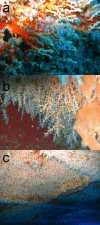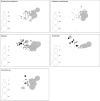The alien octocoral Carijoa riisei is a biogenic substrate multiplier in artificial Brazilian shipwrecks
- PMID: 34642570
- PMCID: PMC8497147
- DOI: 10.1007/s10452-021-09908-8
The alien octocoral Carijoa riisei is a biogenic substrate multiplier in artificial Brazilian shipwrecks
Abstract
Despite the obvious negative effects caused by invasive species, some recent studies have shown that the impacts at local scale are diverse and not necessarily negative. Arborescent benthic organisms such as octocorals form three-dimensional structures capable of increasing the amount of substrate available and providing shelter for epibiont species. We investigated the role of the alien octocoral Carijoa riisei on the diversity of benthic communities in three shipwrecks on the north-eastern coast of Brazil. We expected that (a) the fauna associated with the octocoral are richer and more diverse compared to the adjacent; (b) some species are exclusively associated with C. riisei; (c) the species that are present both in the areas with and without C. riisei have a greater abundance when associated with the octocoral. For this, we compared the macrobenthic communities associated with C. riisei to those found in adjacent areas where the octocoral was absent. Our study showed that the communities associated with the octocoral were 1.5 times richer and 10 times more abundant than adjacent communities, with 29 exclusive taxa. The dominant taxa were the amphipods Ericthonius brasiliensis and Podocerus brasiliensis and polychaetes of the family Syllidae. These taxa were present in areas with presence and absence of C. riisei, but their abundance was significantly greater where the octocoral was present. Our results reinforce the idea that Carijoa riisei acts as an ecosystem engineer in coastal reefs, creating new habitats and increasing diversity at a local scale, even though it is an alien species.
Keywords: Artificial reefs; Epibiosis; Non-indigenous species; Non-native species; Octocorallia; Soft coral.
© The Author(s), under exclusive licence to Springer Nature B.V. 2021.
Conflict of interest statement
Conflict of interestThe authors declare that they have no conflict of interest.
Figures





References
-
- Amaral FD, Farrapeira CMR, Lira SM, Ramos CA. Benthic macrofauna inventory of two shipwrecks from Pernambuco coast, Northeastern of Brazil. Rev Nordest Zool. 2010;4:24–41.
-
- Anderson MJ, Gorley RN, Clarke KR. PERMANOVA+ for PRIMER: guide to software and statistical methods. PRIMER-E: Plymouth; 2008.
-
- Baillon S, Hayes VEW, Hamel JF, Mercier A. Seasonality in reproduction of the deep-water pennatulacean coral Anthoptilum grandiflorum. Mar Biol. 2014;161(1):29–43. doi: 10.1007/s00227-013-2311-8. - DOI
LinkOut - more resources
Full Text Sources
